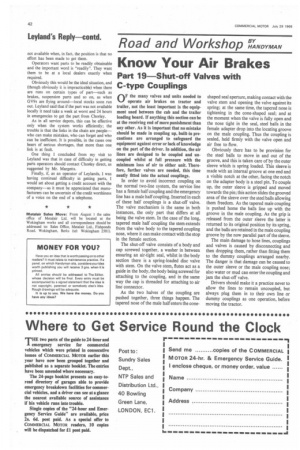Know Your Air Brakes
Page 44

If you've noticed an error in this article please click here to report it so we can fix it.
Part 19—Shut-off Valves with C-type Couplings
OF the many valves and units needed to operate air brakes on tractor and trailer, not the least important is the equipment used between the cab and the trailer loading board. If anything this section can be at the receiving end of more punishment than any other. As it is important that no mistake should be made in coupling up, built-in precautions are arranged to safeguard the equipment against error or lack of knowledge on the part of the driver. In addition, the air lines are designed to be coupled and uncoupled whilst at full pressure with the minimum loss of air to either unit. Therefore, further valves are needed, this time neatly fitted into the actual couplings.
In order to avoid incorrect coupling on the normal two-line system, the service line has a female half coupling and the emergency line has a male half coupling. Inserted in each of these half couplings is a shut-off valve. The valve mechanism is the same in both instances, the only part that differs at all being the valve stem. In the case of the long, tapered male half coupling the stem extends from the valve body to the tapered coupling nose, where it can make contact with the stop in the female section.
The shut-off valve consists of a body and cap screwed together. a washer in between ensuring an air-tight seal, whilst in the body section there is a spring-loaded disc valve with stem. On the valve stem, flutes act as a guide in the body. the body being screwed for attaching to the coupling, and in the same way the cap is threaded for attaching to air line connector.
As the two halves of the coupling are pushed together, three things happen. The tapered nose of the male half enters the cone shaped seal aperture, making contact with the valve stem and opening the valve against its spring; at the same time, the tapered nose is tightening in the cone-shaped seal; and at the moment when the valve is fully open and the nose tight in the seal, steel balls in the female adapter drop into the locating groove on the male coupling. Thus the coupling is sealed, held firmly with the valve open and air free to flow.
Obviously there has to be provision for the steel balls to move in and out of the groove, and this is taken care of by the outer sleeve which is spring loaded. This sleeve is made with an internal groove at one end and a visible notch at the other, facing the notch on the adapter body is a steel pin. To couple up, the outer sleeve is gripped and moved towards the pin; this action slides the grooved area of the sleeve over the steel balls allowing them freedom. As the tapered male coupling is pushed home the balls line up with the groove in the male coupling. As the grip is released from the outer sleeve the latter is returned to its original position by its spring. and the balls are retained in the male coupling groove by the now parallel part of the sleeve.
The main damage to hose lines, couplings and valves is caused by disconnecting and then dropping them, rather than fitting them to the dummy couplings arranged nearby. The danger is that damage can be caused to the outer sleeve or the male coupling nose; also water or mud can enter the coupling and jam the shut-off valve.
Drivers should make it a practice never to allow the lines to remain uncoupled, but always plug them in to their own line or dummy couplings as one operation, before moving the tractor.
































































































































































